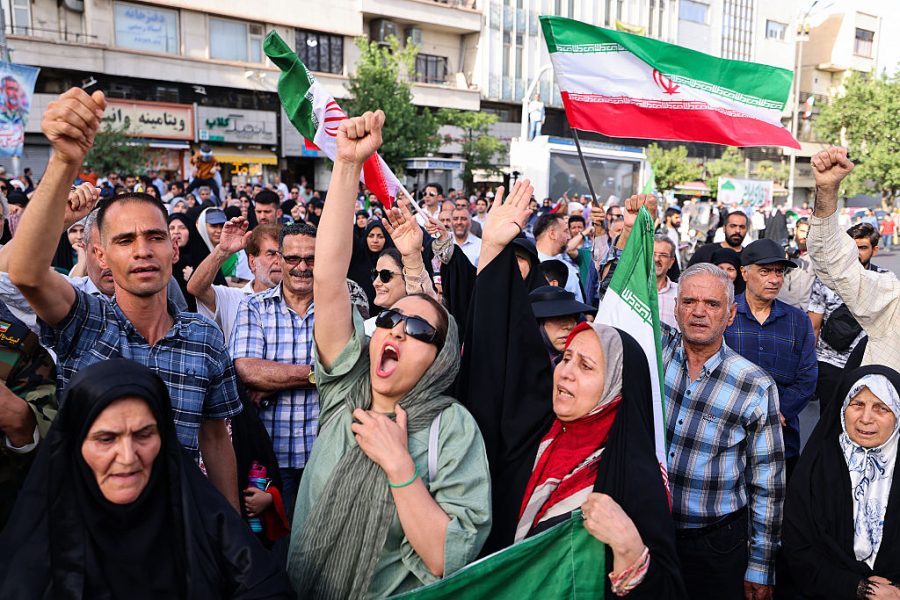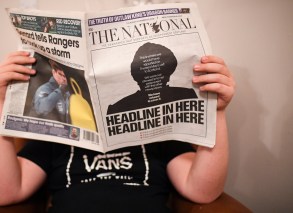Last night began with dramatic news: the Islamic Republic of Iran had launched a volley of ballistic missiles at the US-run Al Udeid airbase in Qatar, a retaliatory gesture following the devastating American strikes on the Iranian regime’s nuclear facilities. In Washington, President Trump entered the National Security Council, according to some reports accompanied by the nuclear ‘football’. The world held its breath in what was turning into the highest-stakes game of chess.
Soon it happened: Trump had indeed pressed the button and unleashed chaos and mayhem across the region. But it was not the one that launches missiles. Instead, it was the presidential CAPS LOCK. Trump took to social media with a volley of his own: a string of taunting, triumphant declarations, including ’14 Missiles Launched, 13 Intercepted, 1 Harmless, No Americans Harmed. THANK YOU for your Attention to this Matter!’ and the witheringly dismissive, ‘They have gotten it all out of their “system”.’ The rhetorical crescendo came with an all-caps benediction: ‘CONGRATULATIONS WORLD, IT’S TIME FOR PEACE!’
Trump posted repeatedly overnight, each time more jubilant, more exclamatory, more drenched in digital EXALTATION. His declarations of PEACE escalated at times into something approaching messianic fervour, even as Israeli airstrikes intensified across Iran, and Tehran continued to fire ballistic missiles at Israeli civilians. By the morning, as the CEASEFIRE time approached, we were once again rushing in and out of bomb shelters as our phone alerts blared out warnings.
Over the past 11 days, the Islamic regime in Iran has been unmasked
To be fair, it was never clear when the ‘Complete and Total CEASEFIRE’ would start or who, in fact, had agreed to it and when. The timings were confusing. It would start ‘in approximately 6 hours from now,’ he wrote, ‘when Israel and Iran have wound down and completed their in progress, final missions!’ It would last ‘for 12 hours, at which point the War will be considered, ENDED! Officially, Iran will start the CEASEFIRE and, upon the 12th Hour, Israel will start the CEASEFIRE and, upon the 24th Hour, an Official END to THE 12 DAY WAR will be saluted by the World. During each CEASEFIRE, the other side will remain PEACEFUL and RESPECTFUL.’ He concluded with characteristic flourish:
On the assumption that everything works as it should, which it will, I would like to congratulate both Countries, Israel and Iran, on having the Stamina, Courage, and Intelligence to end, what should be called, ‘THE 12 DAY WAR’.
But as six hours, twelve hours, twelve days – whatever it was – wear on, the explosions have only grown louder. Was it a desperate final barrage? A last act to cripple some keystone of the regime’s machinery? A parting statement of force? No one could say. Only that the war was not quite over when we rushed into our bomb shelters, clutching hastily made coffees. One barrage, again aimed deliberately at civilians, murdered four more people in southern Israel. So much for PEACE.
Trump declared with characteristic exuberance: ‘This is a wonderful day for the world, I think Israel and Iran will never shoot at each other again.’ But the cost, and the result, is clear. Iran’s nuclear infrastructure lies in ruins. Israel and the US have destroyed the core of the regime’s strategic capability. Israel alone eliminated two-thirds of Iran’s long-range launchers, decapitated its nuclear leadership, targeted its military elite and struck hundreds of regime sites. Tehran, in turn, killed 29 civilians, including three this morning, and struck civilian infrastructure, including the Weizmann Institute and a major power facility. Last night, another Iranian nuclear scientist was killed. Explosions continued across Tehran. Beersheba suffered fresh casualties.
As the dust starts to settle, we begin to see what was achieved. The Islamic Republic has suffered great humiliation through strategic exposure and symbolic degradation. Israel did not just target nuclear and military infrastructure; it dismantled emblems, too. Evin Prison, where the regime has long imprisoned and tortured dissidents and innocents, was hit. So too was the preposterous, bombastic countdown clock in Iran’s ‘Palestine Square’, a theatre prop absurdly ticking toward Israel’s destruction. Yesterday, Israel struck not just nuclear or missile-related sites, but alsoTehran’s Basij HQ and other IRGC internal-security foundations, killing ‘hundreds of IRGC members’ and devastating internal security command nodes. This was not mission creep or over-reach, but a series of deliberate acts of narrative demolition, essential for weakening the enemy’s grip and power to instil fear.
Iran’s retaliation on the US base in Qatar, meanwhile, was intercepted, ineffective, and diplomatically costly. Its missiles were shot down. Qatar condemned the attack. The Pentagon reported no casualties. The global oil market dipped in collective disinterest. Even the regime’s visual propaganda posted on X – a stylised image of an American flag in flames amidst ruins – couldn’t mask the gap between fantasy and fact. No US bases burned. No casualties fell. The only wreckage was reputational.
And then came Trump’s theatre: taunting, triumphal, and strategically belittling. While Tehran issued grand pronouncements, Washington delivered a barrage of digital dominance. The regime’s fearsome image collapsed into farce.
Today, a window opens. Not in Washington or Jerusalem, but in Tehran
Over the past 11 days, the Islamic regime in Iran has been unmasked. Its nuclear ambitions decapitated. Its military elite degraded. Its symbols desecrated. And, crucially, its aura of deterrence dissolved. The regime that once inspired fear now invites ridicule. It remains dangerous, but it is no longer as feared. And that shift, the erosion of fear, is perhaps the most lethal blow of all.
For decades, the Islamic Republic’s power rested not only on weapons, but on the perception of inevitability. That perception is now fractured. No one is pretending regime change can be delivered from abroad. But every intercepted missile, every mocking tweet, every shattered myth lays the groundwork for something more profound: the possibility that the Iranian people, stripped of fear, might one day confront their rulers not as subjects, but as a sovereign people. It is not for the US or Israel to remove the Ayatollahs from power, nor to find and nurture their replacement. Only Iranians can do that.
The same strategic logic applies to Gaza: it is not Israel’s duty to construct a Palestinian political future. It is Israel’s duty to dismantle those committed to its destruction. What arises from those ruins is not Israel’s to shape. If anything viable remains once the hatred and barbarity is defeated, it will be for Palestinians themselves to define. In both cases, Persian and Palestinian, the principle is the same: destroy the machinery of tyranny and terror; let the future be born in the vacuum that follows. Not imposed, not imported, but made possible through the clarity of defeat and a peace born of power and complete victory.
Iran’s regime is still cruel, still repressive. But it is weaker than it has been in decades. Strategically exposed, symbolically humiliated, and psychologically diminished. The emperor, finally, is naked.
But we must still be cautious. The world, weary of sirens and smoke, sighs in relief. And in doing so, it risks forgetting who this regime is: a theocracy driven by the doctrines of Khomeini, who wrote that ‘Israel is a cancerous growth that must be uprooted’. This is not rhetoric, but theology. A divinely sanctioned campaign to erase the Jewish state, not for policy, but for purity. To trust too much in peace with such a regime is to forget history, and to gamble with the future.
Today, a window opens. Not in Washington or Jerusalem, but in Tehran. A moment, perhaps fleeting, in which the Iranian people may see their rulers for what they are: brittle, exposed, afraid. The question is not what the West will do. The question is whether the Iranian people will act. Will the women who led protests in the streets lead something larger? Will the lorry drivers once again unite? Will fear, once lost, remain buried? And if not now, when?







Comments